Nizom Ermatov1, Nodirbek Yusufov2, Dilshod Alimukhamedov3, Raxatjon Duschanova4, Mavlonjon Nasridinov5, Sardor Fayziboev6
1Doctor of Medical Sciences, Associate Professor, Tashkent Medical Academy, Uzbekistan
2Basic Doctoral Student, Tashkent Medical Academy, Uzbekistan
3Associate Professor, Tashkent Medical Academy, Uzbekistan
4Researcher, Urgench Branch of Tashkent Medical Academy, Uzbekistan
5Researcher, Fergana Medical Institute of Public Health, Uzbekistan
6Student, Tashkent Medical Academy, Uzbekistan
Copyright © 2021 The Author(s). Published by Scientific & Academic Publishing.
This work is licensed under the Creative Commons Attribution International License (CC BY).
http://creativecommons.org/licenses/by/4.0/

Abstract
The research covered 13 classes available at the school in hot climates. 4 of them are elementary (grades 1-4); it was conducted in 7 middle (5-9 grades) and 2 high (10-11 grades). The organization of the educational process in the school was carried out on the basis of daily and weekly regulations of the Department of Public Education and normative documents SanQvaN №0341-16 “Sanitary and epidemiological requirements for the organization of educational conditions in secondary schools” and 0375-2020 “Temporary sanitary-epidemiological requirements for the organization of general secondary schools and boarding schools of special secondary schools in the Republic of Uzbekistan during the pandemic COVID-19”. The order and structure of shifts of primary, middle and upper grades in the school do not meet the hygienic requirements, the options of breaks are radically out of order. Temporary non-compliance with temporary hygienic requirements in COVID-19 conditions, placement of complex and irregular subjects on Thursdays and Fridays from primary grades, cases of severe mismatch in middle grades 5-6-7, placement of complex lessons on Mondays and Saturdays, home the time allotted for the performance of the task was not used wisely. This creates a situation of statistical fatigue among students.
Keywords:
Lesson schedule, Level of complexity of lessons, Fatigue and tiredness
Cite this paper: Nizom Ermatov, Nodirbek Yusufov, Dilshod Alimukhamedov, Raxatjon Duschanova, Mavlonjon Nasridinov, Sardor Fayziboev, Hygienic Analysis of the Educational Process in Schools in Hot Climates During the COVID-19 Pandemic, American Journal of Medicine and Medical Sciences, Vol. 11 No. 10, 2021, pp. 734-739. doi: 10.5923/j.ajmms.20211110.15.
1. Introduction
The relevance of the problem. The improvement of all sectors of the country depends on the arrange in which the framework of education and upbringing is organized in them. The reaction of students to different environmental and other factors is covered in a number of research papers [16, pp. 448; 17, pp. 28-29; 18, pp. 43-49; 19, pp. 29-47; 20, pp. 45-51]. According to V.R.Kuchma, one of the most errands of modern schools is to follow a healthy way of life, along with the adjustment of each student's individual capacities, personality and high-tech to a competitive world framework [4, pp. 131-134; 9, pp. 34-40; 10, p. 24; 15, pp. 98-106]. The quality of education in a school and its adequacy depends on an agenda structured in accordance with the hygienic necessities of students and a viably organized learning process. Improperly organized learning process leads to changes within the mental state of understudies as well as varying degrees of fatigue, tiredness and diminished capacity to work.
2. The Main Findings and Results
Among the various sectors of the country are tasks aimed at developing the medical sector, adapting the medical system to world standards, reducing changes and diseases caused by the negative impact of harmful and dangerous factors of the internal environment on children in educational institutions. In accordance with the Action Strategy for the five priority areas of development of the Republic of Uzbekistan for 2017-2021, tasks such as “.... promotion and improvement of a healthy lifestyle, improving the quality of the educational process, reforming various educational institutions, improving and developing the quality of education” [1] are set to raise the level of medical services to a new level. These tasks include improving the educational conditions of children and adolescents in various educational institutions, preventing the negative impact of intra-school factors, and organizing an effective agenda.In the 2020-2021 academic year, there are 10008 schools within the country with 6 million 236 thousand 751 students, whereas in Syrdarya region 155 thousand 981 students study, which is 2.5% of the entire number of children in the country. The reason of the research. It comprises of a hygienic analysis of the organization of the educational process in schools in hot climates amid the COVID-19 pandemic. Materials and strategies of investigate. Within the 2020-2021 academic year, research was conducted at school No. 30 in Gulistan district of Syrdarya region. The school is one of the littlest schools within the nation. The results obtained were based on explanatory analysis. The materials of the study secured all 13 classes of 11 years accessible in the school. 4 of them are elementary (grades 1-4); It was conducted in 7 middle (5-9 grades) and 2 upper (10-11) grades. It should be noted that in the new school year was carried out on the premise of two upper grades, to be specific 8-9 and 10-11 grades. The organization of the instructive prepare within the school was carried out on the premise of daily and weekly controls of the Department of Public Education and the regulating document SanQvaN №0341-16 “Sanitary and epidemiological necessities for the organization of educational conditions in secondary schools” [2]. The educational process at the school was carried out online and offline. The online mode was organized on the premise of TV programs of the Central TV of the Republic of Uzbekistan, requiring parents to work with students for a limited period of time.Despite the fact that schools are not fully prepared for the online learning process and teachers are not fully prepared for the learning process, the online learning process has been carried out without an in-depth analysis of the current situation.The organization of the educational process in the school was carried out on the basis of daily and weekly loads of the Department of Public Education and SanQvaN0036-2019 and SanQvaN 0375-2020 “Temporary sanitary-epidemiological requirements for the organization of general secondary schools and boarding schools of special secondary schools in the Republic of Uzbekistan during the pandemic COVID-19” (2,3) in pandemic conditions. The obtained results were analyzed analytically.Analysis of the obtained results. The foremost important part of the school students’ agenda is the learning process. The distance between students and the school at home is 100 meters to 3.0 km. Pupils come and go to school on foot. Major highways and railways, open water sources, large markets, and pharmacies are among the schools and private zones; there are no enterprises and organizations related with other destructive components, which meet the hygienic requirements.The land area and building of the school do not meet the complete hygienic requirements, as the school is housed in a 3-storey college building. The project is outlined for 960 places, but amid the study period it was found that in hone 455 students are studying. The overall capacity of the students in the school meets the hygienic requirements. The quarantine of March 14, 2020 in our country is still going on to this day. From the beginning of the 2020-2021 school year, schools were required to continue themstudies under isolate conditions. Classes were conducted online and offline. The school has a kitchen for children to eat, but buffet products and fast items are disseminated there. During the day, students spend the rest of their time doing homework in their homes and some children locks in in circle activities. Unfortunately, in spite of the truth that the school has data technology, language learning rooms, a gym, it does not fully meet the hygienic requirements.Table 1. The work schedule of the first shift for the primary grades of the school
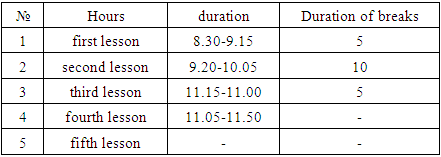 |
| |
|
The non-compliance of a number of students amid the quarantine period, when classes were carried out according to the arrange, caused extreme changes in their agenda. Data were gotten from a hygienic analysis of their online course materials. The structure of the move within the primary grades of the school does not meet the hygienic requirements. The length of the breaks was assumed to be organized on a 10-20-10 basis, however, this school was organized on a 5-10-5 basis. This is the first source of physiological exhaustion of students amid the lesson. In spite of the framework of activity of the current sanitary normative document and the foundation of a five-day work plan per week, specific changes have been made in the school agenda.The agenda of the middle and upper grades of the school and its structure are given in Table 2.Table 2. The structure of the school day of middle and high school
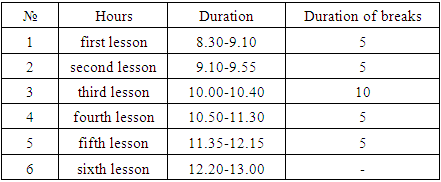 |
| |
|
From the data presented in Table 2, it can be seen that the agenda of both the middle and upper classes does not meet the hygienic requirements. The optimal options for breaks were to match the initial 10-20-20-10 and 10-30-10-10 options. However, the option of school break breaks does not meet hygienic requirements. The duration of the lessons is 40 minutes. This caused shifts in hygienic requirements, and the duration of the lessons had to be 45 minutes. We analyze the duration of daily and weekly loads by comparing them with the analysis of the following tables.The structure of the school's second shift agenda is shown in Table 3.Table 3. Allocation of time budget in the second shift
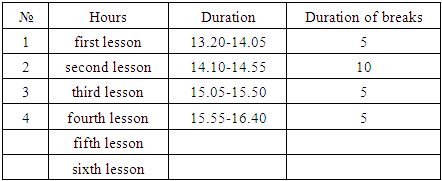 |
| |
|
The working day of the primary classes in the school is 5 days, 4 lessons a day, 4 lessons a day. There is no time for a second breakfast for children studying in the second shift. In schools where the first shift was working, time had to be set aside for a moment breakfast, unfortunately, this control was not taken into consideration. During the COVID-19 pandemic, the organization of working conditions in educational institutions did not meet the requirements set out in the SanQvaN. There is no time for students to ventilate the rooms amid the breaks between classes, to drink tea and water, to have a moment breakfast and lunch, and to have a cup of tea. This demonstrates that the school administration has violated the foremost basic clean necessities or is new with the lawful regulations that may be used amid the action, or has committed serious infringement.The school did not ventilate the rooms after each lesson, taking into account the epidemiological situation, and did not clean them with disinfectants. Students are provided with hot water and masks. Medical personnel periodically performed temperature measurements on children.Mental and physical development of students during the day and lessons depends on the state of health, in-school factors, microclimate indicators of classrooms, ensuring high efficiency of work, the organization of lessons on the basis of hygienic requirements (5,6,7,8,9,10).The loads of students during the day and week depend on the physiological high and low days of their performance and the level of complexity of the lessons.The days of the week that provide the highest performance are Wednesday and Thursday, and the days that provide the lowest performance are Monday and Saturday (9.10).Saturday is a day off for elementary school students. A 5-day work schedule has been approved in the primary grades and a 6-day work schedule in the middle and upper grades.The structure of the school timetable and the distribution of lessons by level of complexity are given in Tables 4-5.Table 4. Color distribution of study hours (in points) depending on the level of weight during the days of the week in grades 1-4
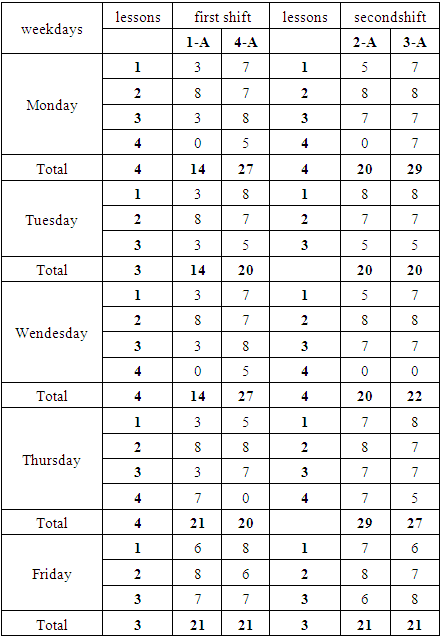 |
| |
|
Table 5. Color distribution of study hours (in points) depending on the level of complexity during the week in grades 5-9
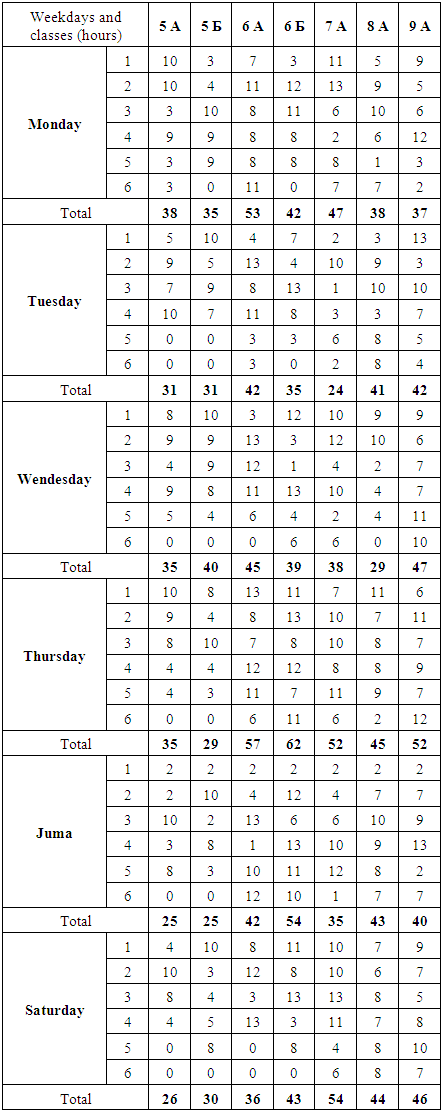 |
| |
|
The scoring analysis of the daily and weekly load of class 1-A shows that the sum of the total difficulty level scores on Mondays and Fridays is 14; 14; 14 and 21 points respectively. He scored 21 points on Thursday and Friday.The 21 points set on Friday have been linked to severe fatigue and tiredness in students, according to scientific sources [4, pp. 131-134; 9, pp. 34-40; 10, pp. 24; 11, pp. 37-40].This leads to a sharp disruption of the schedule, various levels of fatigue, as well as a number of functional changes in the health of students, along with a decrease in the ability to work on weekends ([11, pp. 37-40; 12, pp. 39-40; 13, 39-44; 14, pp. 17-24).In Class 2A, the level of complexity of the daily and weekly loads meets the hygienic requirements.In Class 3A, Monday was 29 points despite being the hardest day of the week, and 20 to 21 points the rest of the day.Complex lessons on Monday affect your ability to work the rest of the week.In Class 4A, meanwhile, he scored 27 points on Mondays and Thursdays, which is also incorrect, as Monday is a physiologically difficult day of the week.A hygienic analysis of the lesson schedule for primary grades shows that the placement of Monday lessons in grades 2-4 requires reconsideration.Example: In elementary grades, we performed a hygienic analysis of lesson components based on timing.In grade 1-A, learning activity was 56.5% among students and motor activity was 43.5%. The teacher identified a number of shortcomings in the components of the lesson.The course should consist of an introduction, a main portion and a conclusion. However, the teachers did not pay consideration to the introduction and conclusion part. The chronological structure of the lesson was not followed. This leads to a monotonous nature of the lesson in students. New academic methods of teaching were not used by the educator. As it were the traditional training system was implemented. Implementing lessons in this order has a negative effect on students’ mastery of subjects. This analytical analysis was performed in all classes within the science section. The mastery and quality of the students under control was 100%, which is how to explain it.In the middle grades, i.e. in 5 “A” classes on Monday, the level of complexity of the lessons was 38 points, in the 1st and 2nd classes the lessons were assigned a scale of 10 points, which does not fully meet the hygienic requirements.The total complexity level of the daily downloads on Tuesday was 31 points.The total score of the lessons on Wednesdays and Thursdays of the week was 35 points. On Wednesday, the first lesson should be replaced by the 3rd lesson. It is necessary to replace the 4th lesson with the first lesson on Thursday.On Friday, the 5th lesson was misallocated by weight level, with a total score of 25 points.The total weight level on Saturday is 26 points, and a subject that is difficult to master in 2 lessons should be moved to Wednesdays or Thursdays of the week.In Grade 5 “B”, the same situation was observed on weekdays with a similar order of 35-31-40-29-25-30 on Mondays, while on Mondays, lessons 3-4 and 5 were randomly placed in the timetable. This, in turn, leads to student fatigue from the beginning of the week.6 “A” On Monday, the level of complexity of the general lessons was 53 points, which does not meet the hygienic requirements at all. If the complex lessons of Saturday’s 2nd and 4th hours are not replaced by other days of the week, the decline in students ’ability to work will lead to a disruption of the dynamic and statistical components of the lessons.The level of complexity of lessons in 6 "B" classes was 42-35-39-62-54-43 points. The daily load on Friday consists of 6 lessons and there are a number of shortcomings in the sequence. The first lesson on Saturday needs to be replaced with other hours.In class 7 “A”, the level of complexity of Monday lessons is 47 points, and in lessons 1 and 2, complex lessons of 11 and 13 points are set, which is completely contrary to hygienic requirements. On Tuesday, however, only light lessons were set and the total sum of the daily difficulty level was 24 points. The distribution of loads is moderate on days of the week when performance is high. On Saturdays, classes for 1-4 hours are very heavy.It should be noted that the rough changes in Mondays and Saturdays of this week in this class cause changes in children not only in science, but also in their functional states during this transition period, especially in the mental system.In our study, we divided grades 8-9-10-11 into upper grades, and considered it appropriate to study the agenda and lesson schedule of these classes separately.The distribution of the time budget allocated to students for homework is given in Table 6.Table 6. The distribution of time for students to complete homework on the school agenda
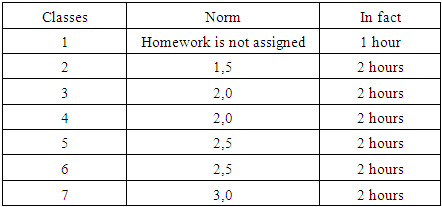 |
| |
|
The time and efficiency of homework of school students is not suitable for hygienic students. Because, as a result of questionnaires conducted among children, the transfer of materials from the educational literature, especially in the performance of homework, and homework assignments were copied by primary school students with the help of their parents and siblings, older students completed homework, and teachers in the classroom decreased students ’thinking ability in assessing homework.It should be noted that the organization of the educational process in the controlled school does not meet the hygienic requirements. Students' schedules, lesson organization, distribution of lessons on difficult and light days of the week depending on the level of complexity, academic hours during the day and week, failure to take into account hygienic requirements in the formation of lesson components, different levels of fatigue, fatigue and reduced ability to work. This, in turn, leads to a deterioration in the psycho-somatic state of the students.
3. Conclusions
1. The school agenda in hot climates is not organized in accordance with the hygienic requirements, the service radius of students in the school and home environment does not meet the hygienic requirements, leading to a change in the student agenda.2. The order and structure of shifts of primary, middle and upper grades in the school do not meet the hygienic requirements, the options of breaks are radically out of order and do not meet the hygienic requirements in COVID-19 conditions at all.3. On Thursday and Friday in grades 1A of primary grades, the complexity of lessons was 21 points, on average 16.8 points, and Friday lessons lead to severe fatigue and exhaustion in students, and in grades 2-3-4 there are cases of incompatibility.4. In the middle grades, even in grades 5-6-7, there are cases of severe mismatch, and difficult lessons on Mondays and Saturdays, during the first and last hours of the week, create conditions for students to get tired during the day.5. Changes in the time allotted for homework indicate that they have not been used wisely.
References
| [1] | Decree of the President of the Republic of Uzbekistan dated February 7, 2017 No PD-4947 “On the Action Strategy for further development of the Republic of Uzbekistan”. |
| [2] | SanMvaQ №0341-16 “Sanitary and epidemiological requirements for the organization of educational conditions in secondary schools”. Tashkent, 2016. |
| [3] | SanMvaQ 0375-2020 Temporary sanitary-epidemiological requirements for the organization of general secondary schools and secondary special boarding schools in the Republic of Uzbekistan during the COVID-19 pandemic. Tashkent, 2020. |
| [4] | Irmatov N.J., G.Kh. (2016) Akhmedova and others. Hygienic requirements for the organization of the agenda of children and adolescents in various educational institutions. Bulletin of the Tashkent Medical Academy, №2. – pp. 131-134. |
| [5] | Ermatov N.Zh., Shaikhova G.I., E.Khasanov. (2012) Hygienic assessment of the effectiveness of the organization and conduct of physical education in educational institutions of different types. Problems of biology and medicine. – Samarkand. No. 2, - pp. 117-121. |
| [6] | Ermatov N.Zh., Khalilov Sh.S. and other. (2015) Hygienic assessment of the organization of the educational process of primary classes in music schools. Journal. – Young Scientist, Russia. - No. 9. (89). – pp. 437-439. |
| [7] | Ermatov N.Zh. and other Hygienic assessment of the organization of physical education in educational institutions of different types. Journal - Young Scientist, Russia 2017. - №23.2 (157.2). – pp. 40-42. |
| [8] | Ermatov N.Zh. and other. Hygienic conditions for teaching adolescents in academic lyceums. Journal. – Young Scientist, Russia 2017. - №23.2 (157.2). –pp. 38-40. |
| [9] | Kuchma V.R., Stepanova M.I., Sazanyuk Z.I., Lashneva I.P., Shumkova T.V., Makarova A.Yu. (2015) Hygienic Evaluation of an Effective High School Curriculum. Sechenov Bulletin. No. 2 (20). – pp. 34-40. |
| [10] | Chaikin S.V. (2002) Hygienic assessment of the alternative version of the structure of the school year at school. Abstract of thesis. Diss. Candidate of Medical Sciences. – Moscow. – p. 24. |
| [11] | Stepanova M.I., Sazanyuk Z.I., Polenova M.A. and other. (2011) Reserves of health care of students in modern school. Russian Pediatric Journal; 6: - pp. 37-40. |
| [12] | Golubnichaya G.I. (2019) Analytical assessment of the regime moments of primary school students. Human health, theory and methodology of physical culture of spoilage. No. 2 (13). – pp. 39–44. URL: http://journal.asu.ru/index.php/zosh. |
| [13] | НедількоВ.П., Камінська Т.М., Руденко С.А. Шляхи покращенняздоров’ яшколярів // Perinatology and Pediatrics. 2006. №1. – pp. 129–132 (на укр. яз.). |
| [14] | Диниміка стану здоров’яшколяріввУкраїні заданими анкетного опитування / Няньковський С.Л., Яцула М.С., Няньковська О.С., Титуса А.В. // Здоровье ребенка. 2018. №5. С. 17– 24. |
| [15] | Semenkova T.N., Kasatkina N.E., Kazin E.M. (2011) “Risk” factors affecting the health of students in the learning process. Bulletin of the KemSU. No. 2 (46) – pp. 98-106. |
| [16] | Smirnov, N.K. (2005) Health-saving educational technologies and health psychology at school. N.K. Smirnov. – Moscow: ARKTI. – p. 448. |
| [17] | Agadzhanyan, N.A. (2004) Emergency situations, stress and biorhythms. N.A. Aghajanyan. Problems of rhythms in natural science: mat. II Int. symposium. – Moscow: RUDN. – pp. 28 – 29. |
| [18] | Butyrskaya I.B. (2019) Rational complex of measures as an element of strengthening the health of schoolchildren studying in conditions of intense mental activity. Tavrichesky medical and biological bulletin. Volume 22, No. 4. – pp. 43-48. |
| [19] | Kuchma V.R. (2010) Comprehensive modernization of the organization of the system of medical support for children and adolescents in educational institutions as a state policy. Materials of the II Congress of the Russian Society of School and University Medicine and Health with international participation. – Moscow: Scientific Center of Children's Health, Russian Academy of Medical Sciences: - pp. 29-47. |
| [20] | Roshchin I.G. Maintaining the health of students of general education schools as a necessary condition for the success of their physical preparation for life. Bulletin on Pedagogy and Psychology of Southern Siberia. 2015; No. 2. – pp. 45-51. |


 Abstract
Abstract Reference
Reference Full-Text PDF
Full-Text PDF Full-text HTML
Full-text HTML




